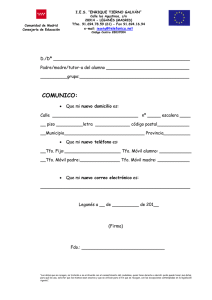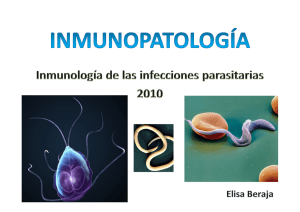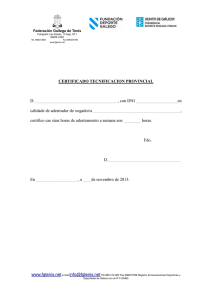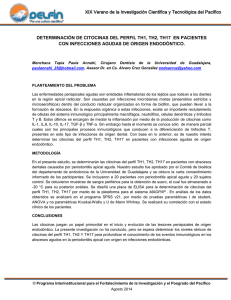Los linfocitos Th1 no son exclusivos de la inmunidad celular
Anuncio
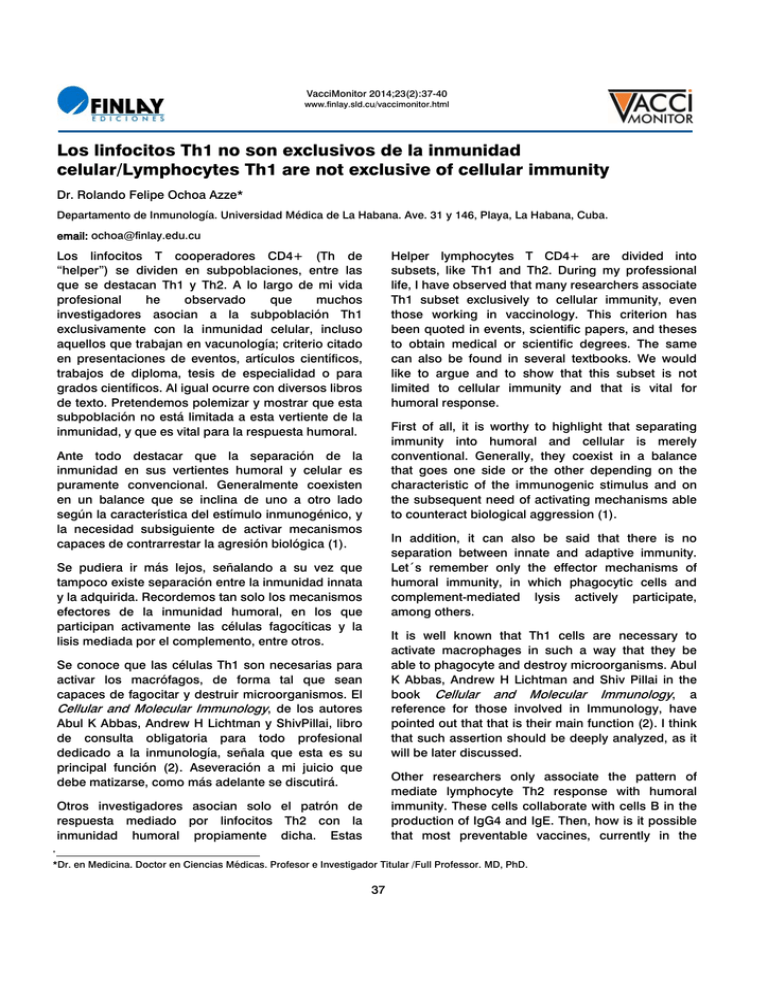
Ochoa RF. VacciMonitor 2014;23(2): 37-40 VacciMonitor 2014;23(2):37-40 www.finlay.sld.cu/vaccimonitor.html Los linfocitos Th1 no son exclusivos de la inmunidad celular/Lymphocytes Th1 are not exclusive of cellular immunity Dr. Rolando Felipe Ochoa Azze* Departamento de Inmunología. Universidad Médica de La Habana. Ave. 31 y 146, Playa, La Habana, Cuba. email: [email protected] Los linfocitos T cooperadores CD4+ (Th de “helper”) se dividen en subpoblaciones, entre las que se destacan Th1 y Th2. A lo largo de mi vida profesional he observado que muchos investigadores asocian a la subpoblación Th1 exclusivamente con la inmunidad celular, incluso aquellos que trabajan en vacunología; criterio citado en presentaciones de eventos, artículos científicos, trabajos de diploma, tesis de especialidad o para grados científicos. Al igual ocurre con diversos libros de texto. Pretendemos polemizar y mostrar que esta subpoblación no está limitada a esta vertiente de la inmunidad, y que es vital para la respuesta humoral. Helper lymphocytes T CD4+ are divided into subsets, like Th1 and Th2. During my professional life, I have observed that many researchers associate Th1 subset exclusively to cellular immunity, even those working in vaccinology. This criterion has been quoted in events, scientific papers, and theses to obtain medical or scientific degrees. The same can also be found in several textbooks. We would like to argue and to show that this subset is not limited to cellular immunity and that is vital for humoral response. First of all, it is worthy to highlight that separating immunity into humoral and cellular is merely conventional. Generally, they coexist in a balance that goes one side or the other depending on the characteristic of the immunogenic stimulus and on the subsequent need of activating mechanisms able to counteract biological aggression (1). Ante todo destacar que la separación de la inmunidad en sus vertientes humoral y celular es puramente convencional. Generalmente coexisten en un balance que se inclina de uno a otro lado según la característica del estímulo inmunogénico, y la necesidad subsiguiente de activar mecanismos capaces de contrarrestar la agresión biológica (1). In addition, it can also be said that there is no separation between innate and adaptive immunity. Let´s remember only the effector mechanisms of humoral immunity, in which phagocytic cells and complement-mediated lysis actively participate, among others. Se pudiera ir más lejos, señalando a su vez que tampoco existe separación entre la inmunidad innata y la adquirida. Recordemos tan solo los mecanismos efectores de la inmunidad humoral, en los que participan activamente las células fagocíticas y la lisis mediada por el complemento, entre otros. It is well known that Th1 cells are necessary to activate macrophages in such a way that they be able to phagocyte and destroy microorganisms. Abul K Abbas, Andrew H Lichtman and Shiv Pillai in the book Cellular and Molecular Immunology, a reference for those involved in Immunology, have pointed out that that is their main function (2). I think that such assertion should be deeply analyzed, as it will be later discussed. Se conoce que las células Th1 son necesarias para activar los macrófagos, de forma tal que sean capaces de fagocitar y destruir microorganismos. El Cellular and Molecular Immunology, de los autores Abul K Abbas, Andrew H Lichtman y ShivPillai, libro de consulta obligatoria para todo profesional dedicado a la inmunología, señala que esta es su principal función (2). Aseveración a mi juicio que debe matizarse, como más adelante se discutirá. Other researchers only associate the pattern of mediate lymphocyte Th2 response with humoral immunity. These cells collaborate with cells B in the production of IgG4 and IgE. Then, how is it possible that most preventable vaccines, currently in the Otros investigadores asocian solo el patrón de respuesta mediado por linfocitos Th2 con la inmunidad humoral propiamente dicha. Estas *Dr. en Medicina. Doctor en Ciencias Médicas. Profesor e Investigador Titular /Full Professor. MD, PhD. 37 Ochoa RF. VacciMonitor 2014;23(2): 37-40 células colaboran con las células B para la producción de anticuerpos de la clase IgG4 e IgE. Entonces, ¿cómo puede sostenerse que la mayor parte de las vacunas preventivas actualmente en el mercado estimulan la vertiente humoral del sistema inmune, si esta se asocia únicamente a las células Th2? Subpoblación que se activa ante helmintos y alérgenos. Por supuesto que este enfoque no es correcto. Las vacunas preventivas timodependientes de subunidades, ampliamente usadas en todos los esquemas de vacunación, inducen anticuerpos de la clase IgG; las proteicas o las de polisacárido conjugadas con proteínas portadoras, en cambio inducen anticuerpos de las subclases IgG1 e IgG3. Características de la respuesta inducida por los linfocitos Th1, mediante mecanismos de cooperación celular. El cambio de isotipo ante el estímulo inmunogénico, natural o artificial, es regulado por las citocinas producidas por las células Th. Este varía según la subpoblación de linfocitos Th que se active, y que a su vez depende de la naturaleza del agente biológico y los mecanismos efectores necesarios para controlar la infección (3). La afirmación de que las células Th1 son importantes en la inmunidad celular es cierta, pero a mi juicio incompleta. No hay dudas de que para un adecuado funcionamiento de esta vertiente del sistema inmune se requiere de esta subpoblación, cuya célula efectora final es el macrófago activado, así como de la actividad de los linfocitos citotóxicos. Sin embargo, la subpoblación Th1 juega un rol vital para la producción de anticuerpos dirigidos contra el agente infectante o sus productos tóxicos (4). Dentro de los anticuerpos protectores se incluyen los que inactivan los productos tóxicos solubles, facilitan la fagocitosis y la digestión intracelular de los microorganismos, fijan el complemento sérico para dañar cápsulas y membranas y neutralizan la proliferación de los gérmenes infectantes (1, 5). Los anticuerpos son eficaces no solo contra bacterias extracelulares, sino contra muchas enfermedades virales, evitando la penetración celular y previniendo que se alcance el órgano blanco, como sucede en el caso del poliovirus o el virus de la hepatitis B. La función efectora de los linfocitos Th1 está market, stimulate humoral branch of the immune system if this is only associated to cells Th2?, a subset that activates in the presence of helminthes and allergens. Of course, this is not correct. Preventive thymusdependent subunit vaccines, which are widely used in all vaccination schemes, induce IgG antibodies. The protein vaccines or polysaccharide-protein conjugate vaccines induce IgG1 and IgG3 antibodies, characteristics of the response induced by lymphocytes Th1, by mechanisms of cellular cooperation. The change of the isotype in the presence of a natural or artificial immunogenic stimulus is regulated by cytokines produced by cells Th. This varies according to the subset of Th lymphocytes that is activated and that at the same time depends on the nature of the biological agent and the effector mechanisms necessary to control infection (3). The assertion that cells Th1 are important in cellular immunity is true, but I think it is incomplete. Undoubtedly, for a proper functioning of this branch of the immune system this subset is necessary, which final effector cell is the activated macrophage, as well as activated cytotoxic lymphocytes. However, Th1 subset plays an important role in the production of antibodies addressed against the infecting agent or toxic products (4). Protective antibodies include those that inactivate soluble toxic products, facilitate phagocytosis and intracellular digestion of microorganisms, fix serum complement to damage capsules and membranes and neutralize the proliferation of infecting germs (1, 5). Antibodies are efficient not only against extracellular bacteria but also against viral diseases, preventing cellular penetration and the reaching of the target organ, as it occurs in the case of poliovirus and hepatitis B virus. The effector function of lymphocytes Th1 is mediated by cytokines that stimulate not only secretion and the class change of antibodies, but also induce local inflammation and increase phagocytic and microbicidal activity of macrophages. In this way both branches of the immune system integrate. It is well known that the defense against biological agents in the extracellular space is more complex 38 Ochoa RF. VacciMonitor 2014;23(2): 37-40 mediada por citocinas, que estimulan no sólo la secreción y el cambio de clase de anticuerpos, también inducen inflamación local e incrementan la actividad fagocítica y microbicida de los macrófagos. De esta forma se integran ambas vertientes del sistema inmune. and requires diverse cells of the immune system: lymphocytes Th1 and Th2 already described; Th follicular and Th17 lymphocytes. Besides, activated cells B and subsequent plasmatic cells, without forgetting the cells presenting antigens, mononuclear phagocytes, neutrophils, mastocytes, basophils and eosinophils. Se conoce que la defensa contra agentes biológicos en el espacio extracelular es mucho más compleja, y requiere del concurso de diversas células del sistema inmune: los linfocitos Th1 y Th2 ya descritos, los linfocitos Th foliculares y los Th17. Además de las células B activadas y las subsecuentes células plasmáticas, sin olvidar las imprescindibles células presentadoras de antígenos, fagocitos mononucleares, neutrófilos, mastocitos, basófilos y eosinófilos. Dr. Andrew H Lichtman, coauthor of the aforementioned book, participated as professor in the Advanced Immunology Course that was held in La Habana, in May, 2011. In the lecture entitled “Cell Mediated Immunity: Helper T Cells”, he referred to some common misconceptions about Th1 and Th2 subsets, which restrict humoral immunity to the latter and limited the former to cellular immunity. However, these criteria should be more clearly defined in the mentioned book. El Dr. Andrew H Lichtman, coautor del libro que se citó en varias oportunidades, participó como profesor en el Advanced Immunology Course que se realizó en La Habana en el mes de mayo del año 2011. En su conferencia, titulada “Cell Mediated Immunity: Helper T Cells” se refirió a errores conceptuales comunes acerca de las subpoblaciones Th1 y Th2, dados por restringir la inmunidad humoral a esta última y limitar la primera subpoblación a la inmunidad celular. Sin embargo, es lamentable que estos criterios no queden claramente definidos y sin ambages en el libro que nos ocupa. I think there is only one immunity. Lymphocyte subsets, better defined in murine models than in human ones, is found in a dynamic equilibrium. Its expansion, differentiation or restriction will depend on the nature of the biological agent. On the other hand, the innate response is found in the genesis of the adaptive immunity, participates in its recognition and activation phase, as well as in its effector mechanisms. Which is the practical importance of these concepts for vaccinology? It can be summarized by saying that the development of vaccines should consider the preferential stimulation of the most suitable branch of the immune system to prevent, control or eliminate the disease. La inmunidad a mi juicio es una sola, las subpoblaciones linfocitarias, mejor definidas en modelos murinos que en humanos, se encuentran en un equilibrio dinámico. Su expansión, diferenciación o restricción, dependerá de la naturaleza del agente biológico. Por otra parte, la respuesta innata se encuentra en la génesis de la adquirida, participa en la fase de reconocimiento y activación de la misma, así como en sus mecanismos efectores. ¿Cuál es la importancia práctica de estos conceptos para la vacunología? Puede resumirse señalando que el desarrollo de vacunas debe tener en cuenta la estimulación preferencial de la vertiente del sistema inmune que sea más idónea para prevenir, controlar o eliminar la enfermedad. 39 Ochoa RF. VacciMonitor 2014;23(2): 37-40 Referencias/References 1. Ochoa R, Sierra G, Martínez I, Cuevas I. Mecanismos de Molecular Immunology. 7th ed., Philadelphia: Saunders; defensa frente a las infecciones (II). Fase efectora de la respuesta inmune. Capítulo 3. En: Prevención de la 2011.p.243-68. 4. enfermedad meningocócica. La Habana: Finlay Ediciones; 2010.p.43-57. 2. Microbes. Chapter 15. In: Cellular and Molecular Immunology.7th ed., Philadelphia: Saunders; 2011.p.345-64. Abbas AK, Lichtman AH, Pillai SH, editors: Effector Mechanisms of Cell-Mediated Immunity. Chapter 10. In: 5. Abbas AK, Lichtman AH, Pillai SH, editors: Effector Mechanisms of Humoral Immunity. Chapter 12. In: Cellular and Molecular Immunology.7th ed., Philadelphia: Saunders; Cellular and Molecular Immunology.7th ed., Philadelphia: Saunders; 2011.p.225-42. 3. Abbas AK, Lichtman AH, Pillai SH, editors: Immunity to 2011.p.269-92. Abbas AK, Lichtman AH, Pillai SH, editors: B Cell Activation and Antibody Production. Chapter 11. In: Cellular and .. 40
